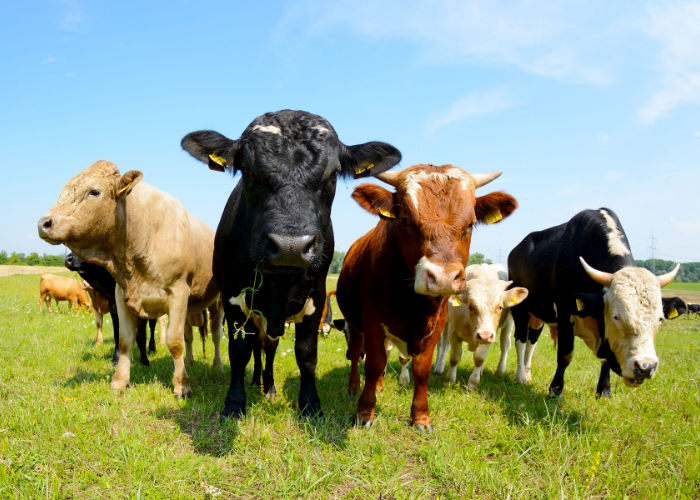Regenerative Livestock Farming: Sustainability and InnovationBy PIETRO PAGANINI
- 22 November 2024
- Posted by: Competere
- Categories: highlights, Media, News, Resilient Food Systems, Responsible Farming

Agenda Digitale has published an analysis by Pietro Paganini on regenerative livestock farming, highlighting how this innovative practice combines natural methods with advanced digital technologies to transform animal husbandry. The article delves into the potential of this approach to promote sustainable and regenerative agriculture, delivering economic, environmental, and social benefits.
Read the full article in Italian on Agenda Digitale or the English version below >>>
Amid the global debate on sustainability challenges, regenerative livestock farming stands as a pivotal yet underexplored topic of growing importance. This approach counters the widespread notion that intensive livestock farming inevitably contributes to soil degradation, pollution, and climate change. Instead, understanding this practice is the first step toward envisioning solutions that are economically viable, environmentally sustainable, and essential for enhancing global food security.
In an era where environmental sustainability takes center stage, regenerative livestock farming emerges as a tangible solution, developed within a sector often unfairly scrutinized. This agricultural practice not only aims to reduce the negative impacts of meat and dairy production but also seeks to regenerate damaged ecosystems, improving soil health, water resources, and the environment as a whole.
WHAT IS REGENERATIVE LIVESTOCK FARMING?
Regenerative livestock farming operates on the fundamental principle that the use of soil and natural resources should go hand in hand with their improvement. Through this approach, farms not only prevent soil degradation but actively promote its restoration using natural techniques that mimic ecological cycles.
Key practices include pasture rotation, controlled grazing, minimizing the use of chemical agents, and restoring biodiversity. For instance, animals are regularly moved to new grazing areas to prevent soil exhaustion, allowing vegetation to recover naturally. This method enhances water retention, reduces soil erosion, and increases the land’s capacity to sequester carbon from the atmosphere.
Additionally, regenerative livestock farming prioritizes ethical animal husbandry. Animals are raised in natural conditions, with ample space and reduced stress, promoting the health of both the animals and the surrounding environment.
SMART FARMING MEETS TECHNOLOGY
There is also a significant link between regenerative livestock farming and the adoption of innovative technologies, which make these practices more efficient and sustainable. One particularly promising example is the use of IoT (Internet of Things) devices and drones for pasture monitoring and management.
Some farmers use GPS collars and sensors to monitor animals’ behavior and soil conditions in real time. These devices collect data on grazing patterns, allowing farmers to optimize rotation schedules and ensure pastures have adequate recovery time. Additionally, analyzing these data helps identify how various climatic and environmental factors impact soil health and vegetation growth.
Drones equipped with multispectral and thermal sensors offer another effective tool for assessing pasture conditions. These drones capture detailed images of grazing areas, revealing degradation hotspots, soil moisture levels, and plant health. Such insights enable timely interventions and optimize rotational grazing practices, improving the efficiency of regenerative land management.
By leveraging sensors and drones, farmers can monitor and manage extensive grazing areas with precision, reducing manual labor and costs. The collected data guides decisions about when and where to move livestock, maximizing soil regeneration.
A GROWING TREND
In recent years, regenerative livestock farming has evolved from a niche agricultural practice into a growing movement supported by scientists and farming enterprises. According to recent estimates by the Rodale Institute, a U.S.-based think tank specializing in organic and regenerative farming, land managed under regenerative principles has increased by about 20% annually worldwide, with countries like the United States, Australia, and Brazil leading the way.
Encouragingly, regenerative farms have demonstrated the ability to capture up to 3 metric tons of CO2 per hectare annually.
Economically, the global market for sustainable agricultural and livestock products, including regenerative ones, reached €1.3 billion in 2022 and is projected to grow by 6–8% annually. This trend reflects a rising demand among consumers for ethically and sustainably produced food.
THE SITUATION IN ITALY AND EUROPE
In Europe, regenerative livestock farming is still in its early stages but is gaining traction thanks to political initiatives and growing public interest in sustainable agriculture. The European Union, through the Green Deal and the new Common Agricultural Policy (CAP), has emphasized reducing agriculture’s environmental impact, incentivizing farmers to adopt regenerative practices.
In Italy, regenerative livestock farming is gradually being adopted, especially in hilly and mountainous regions where small-scale producers are more inclined to experiment with new techniques. Tuscany and Umbria are two regions leading this transition, supported by farmer training programs and the creation of local markets for sustainable products.
ECONOMIC, ENVIRONMENTAL, AND FOOD SECURITY BENEFITS
From an economic perspective, regenerative farms tend to be more resilient over time. While they may require higher initial investments—for example, in farmer training and infrastructure conversion—the long-term benefits outweigh these costs. Regenerated land yields higher-quality crops and forage, requires fewer external inputs (like fertilizers and pesticides), and is less vulnerable to climate change impacts such as droughts and floods.
Environmentally, the advantages are clear: improved soil management enhances carbon sequestration, helping to mitigate climate change. Soil regeneration also boosts biodiversity, benefiting local wildlife and ecosystems. Practices such as rotational grazing and permanent grasslands reduce soil erosion and improve water quality while minimizing the need for intensive irrigation.
Finally, regenerative livestock farming offers a more sustainable model for food production. By relying on systems that are more resilient and less vulnerable to climate or market crises, these farms provide greater long-term stability, ensuring consistent food supplies. Additionally, improved soil and resource quality lead to higher productivity over time.
